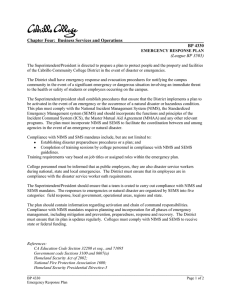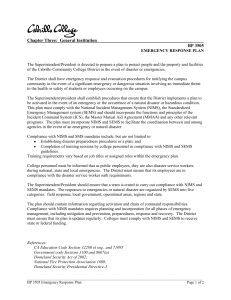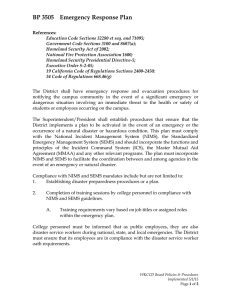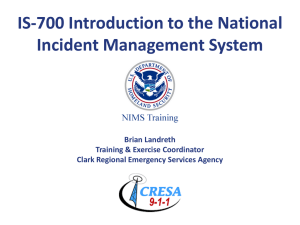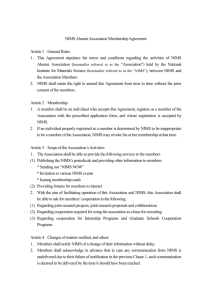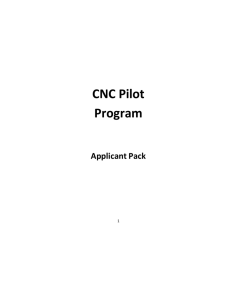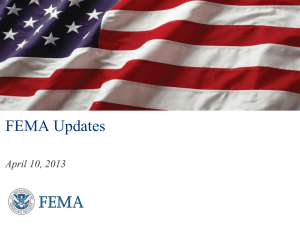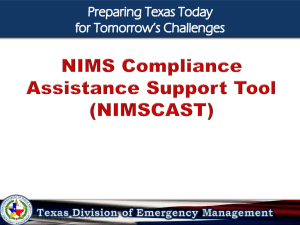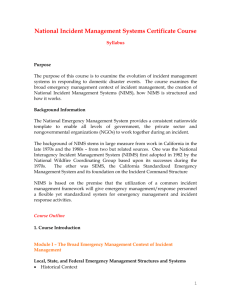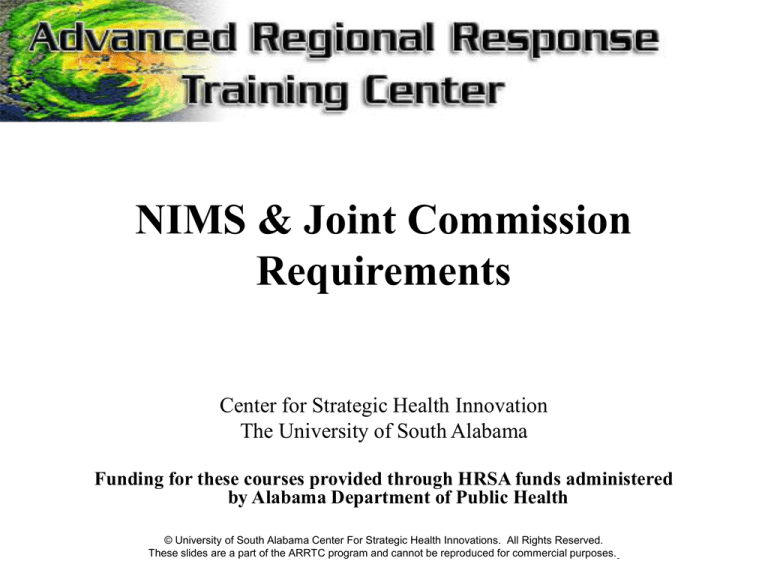
NIMS & Joint Commission
Requirements
Center for Strategic Health Innovation
The University of South Alabama
Funding for these courses provided through HRSA funds administered
by Alabama Department of Public Health
© University of South Alabama Center For Strategic Health Innovations. All Rights Reserved.
These slides are a part of the ARRTC program and cannot be reproduced for commercial purposes.
NIMS is:
• Comprehensive federal system directing response
agencies to function in an organized manner
• Established to coordinate:
– Plans
– Organization Structure
– Training and Exercises
– Resources
– Communications and Technology
Organizational Implementation
Requirements
Adoption:
• Element 1 - Adoption of NIMS
• Element 2 – Federal Preparedness awards support
NIMS Implementation
Preparedness: Planning
• Element 3 – Revise and Update Plans to
incorporate NIMS and NRF components
• Element 4 - Mutual-Aid Agreements
Organizational Implementation
Requirements
Preparedness: Training and Exercises
• Element 5 – IS 100, 200 and 700
• Element 6 – IS 800
• Element 7 – Apply NIMS and ICS to all training
and exercises
Organizational Implementation
Requirements
Communication and Information Management:
• Element 8 – Equipment, Communication and data
interoperability
• Element 9 – Common and consistent terminology
• Element 10 – Systems, tools and processes for
consistent and accurate information
Organizational Implementation
Requirements
Command and Management:
• Element 11 – Manage events with ICS & NIMS
• Element 12 – Use of Incident Action Planning
and common communications plans
• Element 13 – Adopt Public Information (PI)
principles by using both JIS and JIC during events
• Element 14 – PI procedures must gather, verify,
coordinate and disseminate information
NIMS Compliance
• HSPD-5 issued in 2004
• For disaster response agencies and departments,
NIMS made a condition for Federal assistance
• Confusion over initial NIMS compliance for
hospitals and healthcare facilities
• Required to meet as of October 1, 2007.
• Annual requirements – FY 2009 guidelines now
Joint Commission
• The Joint Commission evaluates and accredits
more than 15,000 health care organizations
and programs in the United States.
• An independent, not-for-profit organization,
The Joint Commission is the nation’s
predominant standards-setting and accrediting
body in health care.
Joint Commission
Disaster Preparedness Philosophy:
• Catastrophic emergencies are a threat to any
health care organization, regardless of size,
scope, or location.
• No organization can predict the nature of a
future emergency, nor can it predict the date of
its arrival
Joint Commission
Hospital Accreditation Program
2009 Chapter: Emergency Management
JC – Emergency Management
I. Foundation for the Plan (EM.01.01.01)
II. The Plan for Emergency Response
A. General Requirements (EM.02.01.01)
B. Specific Requirements
1. Communications (EM.02.02.01)
2. Resources and Assets (EM.02.02.03)
3. Security and Safety (EM.02.02.05)
4. Staff (EM.02.02.07)
5. Utilities (EM.02.02.09)
6. Patients (EM.02.02.11)
7. Disaster Volunteers
a. Volunteer Licensed Independent Practitioners (EM.02.02.13)
b. Volunteer Practitioners (EM.02.02.15)
III. Evaluation
A. Evaluating the Planning Activities (EM.03.01.01)
B. Evaluating the Plan through Exercises (EM.03.01.03)
I. Foundation of the Plan
Standard EM.01.01.01
The [organization] engages in planning
activities prior to developing its written
Emergency Operations Plan.
II. The Plan for Emergency Response
A. General Requirements
Standard EM.02.01.01
The organization has an Emergency Operations
Plan.
B. Specific Requirements
1. Communications
Standard EM.02.02.01
As part of its Emergency Operations Plan, the
[organization] prepares for how it will
communicate during emergencies.
B. Specific Requirements
2. Resources and Assets
Standard EM.02.02.03
As part of its Emergency Operations Plan, the
[organization] prepares for how it will manage
resources and assets during emergencies.
B. Specific Requirements
3. Security and Safety
Standard EM.02.02.05
As part of its Emergency Operations Plan, the
[organization] prepares for how it will manage
security and safety during an emergency
B. Specific Requirements
4. Staff
Standard EM.02.02.07
As part of its Emergency Operations Plan, the
[organization] prepares for how it will manage
staff during an emergency.
B. Specific Requirements
5. Utilities
Standard EM.02.02.09
As part of its Emergency Operations Plan, the
[organization] prepares for how it will manage
utilities during an emergency
B. Specific Requirements
6. Patients
Standard EM.02.02.11
As part of its Emergency Operations Plan, the
[organization] prepares for how it will manage
[patient]s during emergencies.
B. Specific Requirements
7. Disaster Volunteer
a. Volunteer Licensed Independent
Practitioners
Standard EM.02.02.13
During disasters, the [organization] may grant
disaster privileges to volunteer licensed
independent practitioners
B. Specific Requirements
7. Disaster Volunteers
a. Volunteer Practitioners
Standard EM.02.02.15
During disasters, the [organization] may assign disaster
responsibilities to volunteer practitioners who are not
licensed independent practitioners, but who are
required by law and regulation to have a license,
certification, or registration.
III. Evaluation
A. Evaluating Planning Activities
Standard EM.03.01.01
The [organization] evaluates the effectiveness of
its emergency management planning activities
III. Evaluation
B. Evaluating the Plan through Exercises
Standard EM.03.01.03
The [organization] evaluates the effectiveness of
its Emergency Operations Plan.
Questions?

